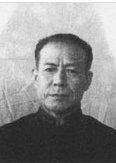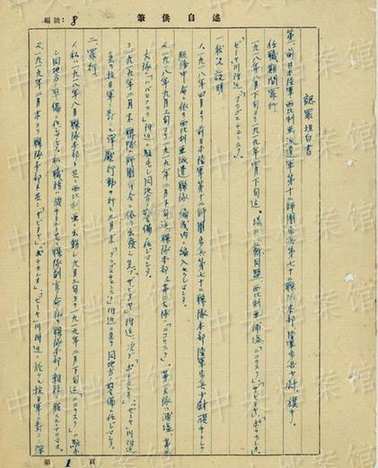當前位置: Language Tips> 翻譯經驗
分享到
據佐佐真之助1954年8月—1956年5月筆供,他1893年出生于日本福岡縣。1932年9月到中國參加侵華戰爭,任關東軍第10師團步兵第63聯隊第3大隊少佐大隊長,1945年7月任關東軍第3方面軍第39師中將師團長。1945年8月23日被蘇軍逮捕。

佐佐真之助
重要罪行有:
1932年10月,“我于佳木斯駐防期間”, “當做密探嫌疑者而逮捕了中國人民約30名”,“其中經拷問后殺害了抗日戰士15名,人民6名”。“在佳木斯東北方約10公里之村莊,”“對戰場村莊的人民給予了損害,依照我的命令殺害5名”。
1940年8月,在浙江莫干山,“我的部下大隊在戰斗中曾使用毒瓦斯(綠筒)給予了重慶軍(即國民黨軍——編者注)戰士莫大的損害”。10月,在浙江諸暨,“殺害了重慶軍戰士約600名,在這里邊包含戰斗中重傷者和被戰士殺害的俘虜推測約40名。這個罪惡是我平常教育須殺害這些俘虜的結果。又各大隊在戰斗中使用毒瓦斯(綠筒),給予了重慶軍戰士很大的損害”。
1941年1月,在浙江杭州,其指揮的第1大隊“逮捕密探嫌疑者約20名,拷問殺害的約7名”;第2大隊“逮捕密探嫌疑者約20名,拷問之后殺害的約9名”;第3大隊“逮捕密探嫌疑者約25名,拷問殺害的約8名”。
1943年12月,在“荷蘭領屬東印度安汶島”,“強制的使用印度尼西亞婦女十數名,設立一個慰安所,供給日本兵士之用,這是對印度尼西亞婦女重大的侮辱行為”。
1944年6月,在從浙江金華向衢州作戰中,“殺傷人民約50名”。
1944年12月—1945年5月,在湖北“逮捕了抗日軍及抗日團之密探嫌疑者共約90名,在調查拷問之下共殺害約30名”,“于步兵聯隊宣撫班,也對中國人民進行欺騙的宣傳,在其行動中虐待人民,其中殺害約6名”。在湖北當陽,“對奮起正義行動的多數人民,毆打虐待致殺害約20名”。“為了教育刺殺練習試斬等使用,慘殺了俘虜5名”。“師團于湖北省駐防期間,在當陽從以前就設立的日本人經營之慰安所,使之供給日本軍隊慰安,師團對此經營予以支持。該慰安所里有中國婦女十數名,都是因日本帝國主義之侵略戰爭,而陷于生活困苦,被強制的收容從事賤業。我想在宜昌、荊門也有和這同樣的慰安所。”
1945年1月,在湖北當陽,“殺害了俘虜約5名”。“師團將各部隊軍官召集到當陽,進行毒瓦斯教育之際,把2名俘虜放入瓦斯室內,為試驗毒瓦斯效力使用。又師團軍醫部,把4名俘虜放入瓦斯室內,進行毒瓦斯效力試驗而虐待,終于把他們都殺害了”。
1945年2月,在湖北沙市西北方馬山屯“殺害了中國無辜人民約15名”。
1945年3月,在湖北襄樊作戰期間,“殺害重慶軍戰士約3500名(于此之中,包含殺害俘虜若干名)”, “殺害中國人民約200名”,“強奸的中國婦女數字約50名”,“燒毀民房約200戶”。“為了隱匿師團之作戰企圖”,“阻止了3名人民通行,并殺害之外,于其他村莊道路等,逮捕虐待人民,殺害十數名”。“在南漳方面作戰中,發現由中國人民4名用擔架搬運2名負傷的重慶軍戰士中,便將該負傷戰士2名殺害,并將逃跑的搬運中之人民4名也射殺了”。“各步兵部隊于攻擊戰斗期間,使用毒瓦斯及炮兵發射瓦斯彈,給予重慶軍損害”。
另:
1932年9月—12月,“殺害人民:作戰時約35名,平常時約8名,計約43名”。
1934年3月—12月,“殺害人民:約10名”。
1936年3月—1937年5月,“殺害人民:約7名”。
1940年3月—1941年3月,“殺害人民:作戰時約3名,平常時約24名,計約27名”,“強奸婦女:平常時1名”。
1942年12月—1944年1月,“殺害人民:作戰時約3名,平常時約21名(以外負傷約15名),計約24名”,“糟蹋婦女(慰安所):十數名”。
1944年2月—11月,“殺害人民:作戰時約50名, “平常時約2名”,“強奸婦女,1名”。
1944年12月—1945年8月,“殺害俘虜:作戰時約6名,平常時做刺殺教育用約5名,試驗毒瓦斯教育用6名,其它5名,共計約22名”。“殺害人民:“作戰時約204名”,“平常時約65名”。“計約269名”。“強奸婦女,作戰時約50名(推測數)”, “平常時約17名(包含慰安所)”,“共計約67名””。
According to the written confession of Nosuke Sasaki from August 1954 to May 1956, he was born in 1893 in Fukuoka Prefecture, Japan. In September 1932, he came to China to join the Japanese War of Aggression against China and served as major and battalion chief of the 3rd Brigade of the 63rd Infantry Regiment of the 10th Division of the Kwantung Army. In July 1945, he became lieutenant general and commander of the 39th Division of the 3rd Front Army of the Kwantung Army. On 23 August 1945, he was arrested by the Soviet Army.
The confessions of Japanese war criminal Nosuke Sasaki

The original text of confession written by Nosuke Sasaki.
Major offences:
October 1932: "during my garrison duty in Jiamusi", "about 30 Chinese people were arrested as spy suspects". "Among them, 15 soldiers and 6 civilians were killed after interrogation with torture." In a village 10 kilometers to the northeast of Jiamusi", "damage was made to people in the villages on the battlefield and 5 people were killed under my command";
August 1940: in Moganshan, Zhejiang, "the battalion under my command inflicted great damage to the soldiers of the Chongqing Army (i.e. the Kuomintang Army, note by the editor) by using poison gas (green colored canisters)". In October in Zhuji, Zhejiang, "about 600 soldiers of Chongqing Army were killed, and among them, 40 had been seriously wounded in combat or taken as captives. This crime was due to my daily instruction that the captives should be killed. All the battalions used poison gas (green colored canisters) in the battles to do great damage to the Chongqing Army soldiers";
January 1941: in Hangzhou, Zhejiang, the First Battalion under his command "arrested about 20 spy suspects and around 7 of them were killed after interrogation with torture"; the Second Battalion "arrested about 20 spy suspects and around 9 of them were killed after interrogation with torture"; and the Third Battalion "arrested about 25 spy suspects and around 8 of them were killed after interrogation with torture";
The confessions of Japanese war criminal Nosuke Sasaki
Confessions of other criminals December 1943: in "Ambon Island, Dutch East Indies", " forced more than 10 Indonesian women to work in a comfort station to serve Japanese soldiers, which was a gross insult to the Indonesian women";
June 1944: in the battles from Jinhua to Quzhou, Zhejiang, "killed about 50 people";
From December 1944 to May 1945: in Hubei, "arrested about 90 spy suspects of the Anti-Japanese Army and anti-Japanese groups, killing about 30 of them through interrogation with torture", and "in the Propaganda Team of the Infantry Regiment, we made deceptive propaganda for the Chinese people, and maltreated them in practice , killing about 6 people". In Dangyang, Hubei, "for the majority of the people who rose in a just act against the aggression, about 20 of them were killed through beating and torture". "To teach Japanese soldiers how to use bayonets and swords, 5 captives were brutally killed". "When the Division is stationed in Hubei, an existing Japanese-run comfort station in Dangyang was used to serve the Japanese soldiers. The Division supported the operation of this comfort station. There were over ten Chinese women in the comfort station, who were subject to hardship by the war of aggression waged by the Japanese imperialists and forced to come here and work in this humiliating business. I think there were similar comfort stations in Yichang and Jingmen";
January 1945: in Dangyang, Hubei, "We killed around 5 captives". "When the Division gathered all the officers in Dangyang and conducted the poison gas training, 2 captives were sent to the gas chamber to test the gas effect. The Medical Department of the Division then put another 4 captives into the gas chamber for the gas effect test. All of them were eventually killed by the poison gas";
February 1945: "we killed about 15 innocent Chinese people" in Mashantun, to the northwest of Shashi, Hubei;
March 1945: during the battles in Xiangfan, Hubei, "killed about 3,500 soldiers of the Chongqing Army (including some captives)", "killed about 200 Chinese people", "raped approximately 50 Chinese women" and "burned down houses of about 200 households"; "In order to conceal the combat intention of the Division", "stopped 3 people from passing through and killed them, besides, on other village roads, arrested and tortured people, and killed over ten people"; "during the battles in Nanzhang, found 2 wounded soldiers of the Chongqing Army carried on stretchers by 4 Chinese people, then killed the two wounded soldiers and shot dead the 4 men when they tried to escape"; "during the battles, all infantry forces used poison gas and the artillery launched gas shells to cause damage to the Chongqing Army";
In addition:
From September to December 1932: "killing people: approximately 35 people in battles and 8 in normal times, totaling about 43";
From March 1934 to December 1934: "killing people: about 10 people";
From March 1936 to May 1937: "killing people: about 7 people";
From March 1940 to March 1941: "killing people: about 3 people in battles and 24 in normal times, totaling about 27"; "raping women: one woman in normal times";
From December 1942 to January 1944: "killing people: approximately 3 in battles and 21 in normal times (wounding about 15 in addition), totaling about 24"; "abused women (comfort station): more than 10 women";
From February to November 1944: "killing people: approximately 50 in battles; 2 in normal times"; "raping women: one woman";
From December 1944 to August 1945: "killing captives: approximately 6 in battles, about 5 in normal times for bayonet teaching, 6 for poison gas training and 5 for other purposes, totaling about 22"; "killing people: approximately 204 in battles" and "65 in normal times", "totaling about 269"; "raping women: about 50 (estimated figure) in battles" and "17 in normal times (including comfort station)", "totaling about 67".
(來源:國家檔案局網站,編輯 Helen)
上一篇 : 習近平在中美戰略與經濟對話開幕式講話雙語要點
下一篇 : 中國大片里的地道英語
分享到
關注和訂閱


電話:8610-84883645
傳真:8610-84883500
Email: languagetips@chinadaily.com.cn